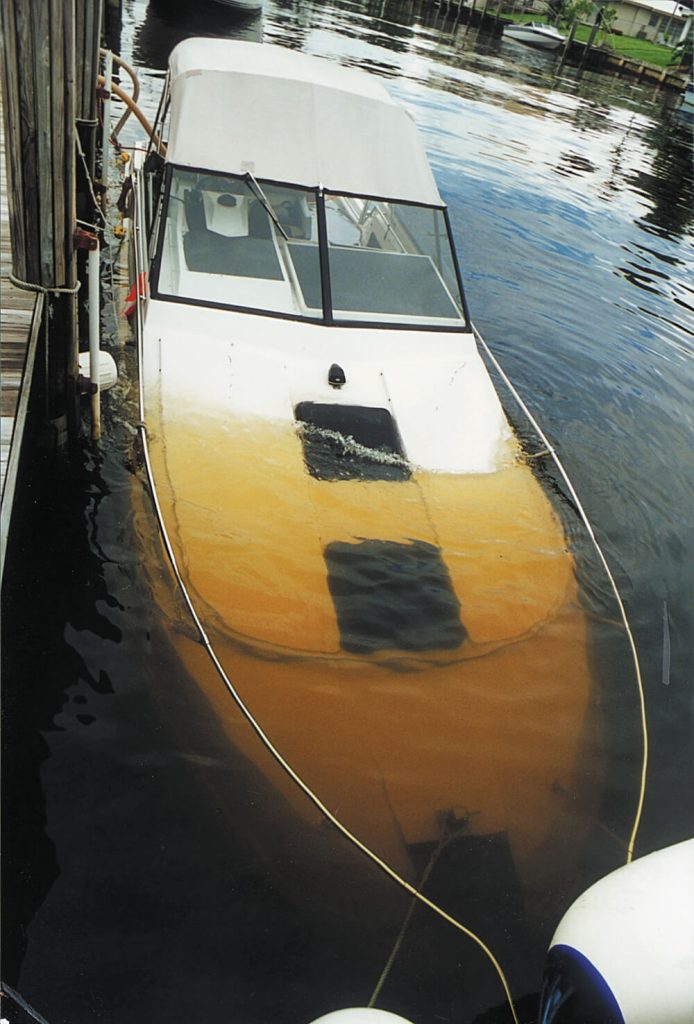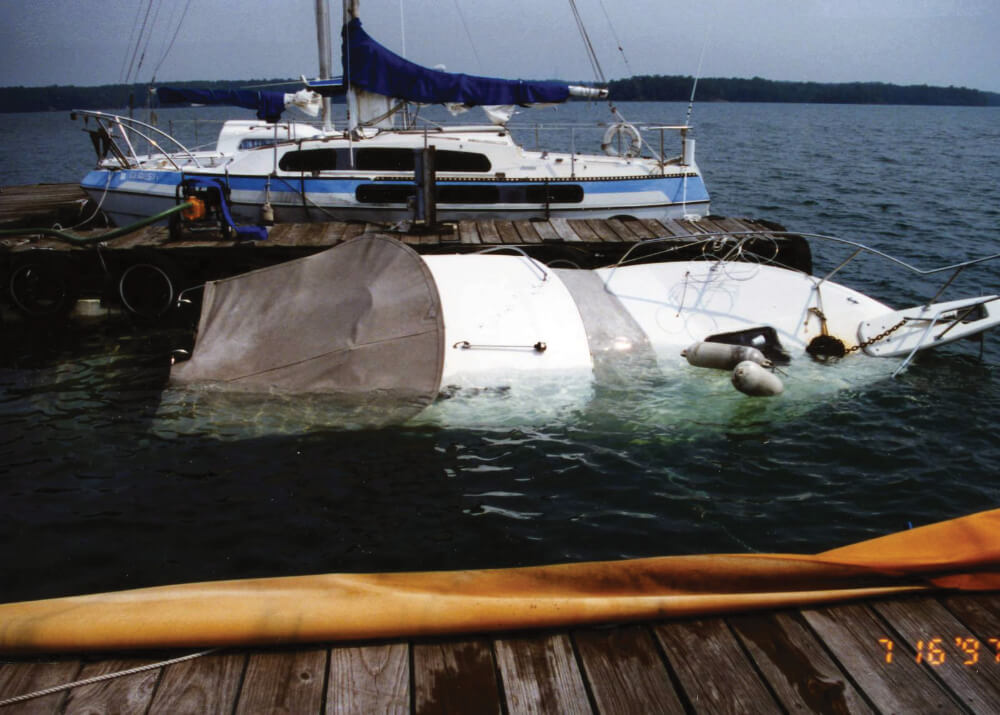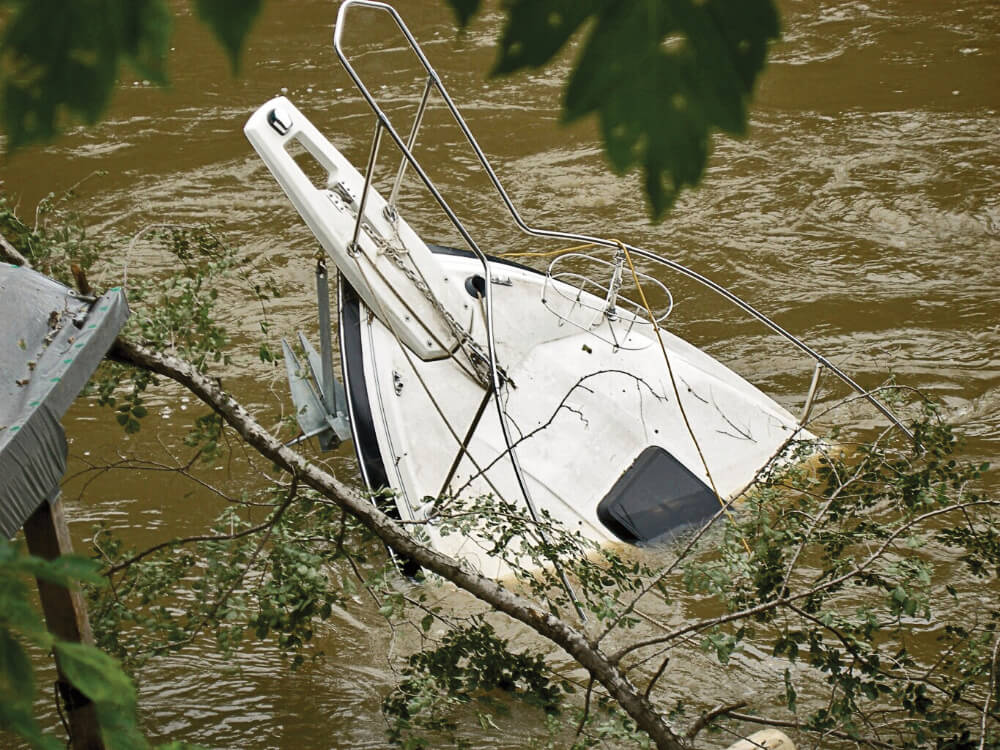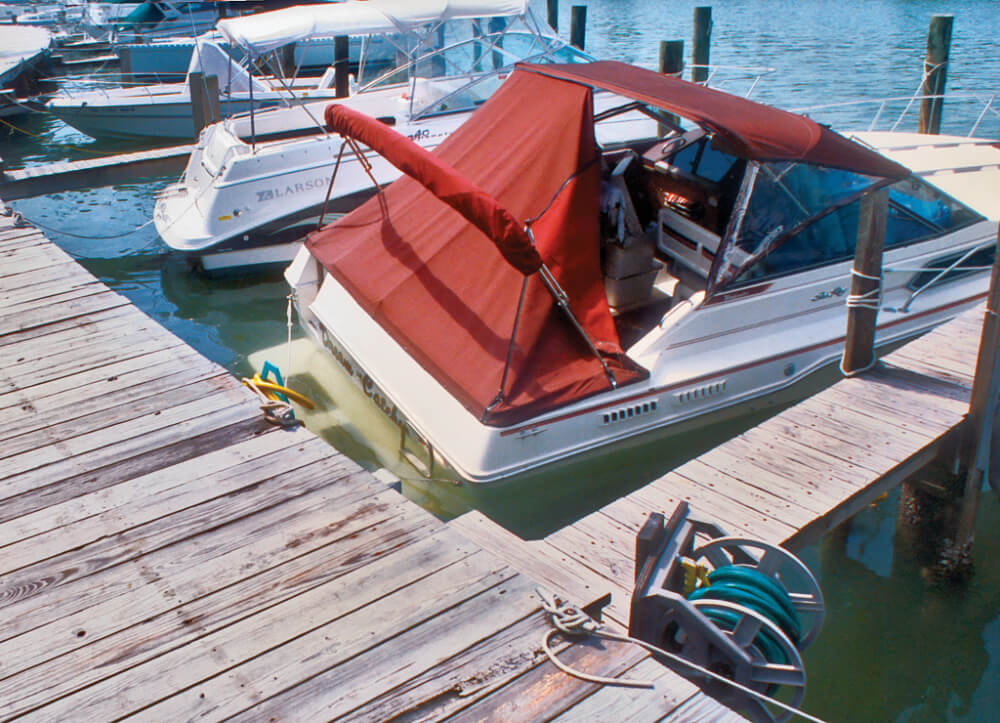Boats that sink in situ not only create financial headaches, but also damage the environment
STAYING AFLOAT
Think your boat is safe at the marina berth? Think again. More boats sink at the marina than anywhere else. Follow these tips to keep your boat afloat.
You think your boat’s safe when it’s tucked up safely in the marina, but the facts say otherwise: According to insurance statistics, more boats sink when they’re unattended than when underway. While you’re reading this your own boat might be collecting water in the bilge, and, according to Archimedes, when there’s enough accumulation, bingo! Down she goes. If that happens, I know what you’ll say: “The bilge pump failed.” But if you’re counting on the pumps to keep Leaky Tiki afloat, you better take anything valuable ashore now, or sooner or later it’ll be in the hands of Davy Jones.
Not to get overly Shakespearean here, but if your boat sinks in the slip the fault lies not in our pumps, but in ourselves. At least it does for inattentive owners. (If you’re reading this, you’re probably not one.) Boats that sink in the supposed safety of their berths generally fall victim to the owner’s failure to follow basic maintenance schedules, inspect the vessel thoroughly on a regular basis, and protect what is usually an expensive investment, and one that deserves better treatment. If the boat’s not new and shiny, but a bedraggled veteran of years of rough service, it’s even more important that someone take pains to keep it on the surface; age catches up with boats just like with people, and senior citizens require extra TLC.

Finally, it’s not just about your investment: Boats that sink in situ not only create financial headaches for their owners and insurers, but also damage the environment and demand that some responsible party raise and either repair or dispose of them. If the boat’s underinsured, as so many older ones are, salvage costs eventually end up in the owner’s lap, where they often remain unpaid, leaving some blameless party out of pocket. Life’s much easier for everyone if boats stay afloat.
WHERE’S THE WATER COMING FROM?
It’s no secret why boats sink: They fill up with water. But how does that happen when the boat’s resting calmly at the marina. Unattended sinkings are often weather-related: Heavy rains combined with blocked scuppers result in flooded cockpits, for example. The rainwater eventually finds its way into the bilge, often through poorly sealed hatches in the cockpit sole. Or rainwater can accumulate over time in loose-fitting canvas, which eventually splits under the weight and dumps the water into the boat, with the same result. Add a clogged bilge pump and/or a dead battery, and eventually—glug, glug, glug. When this happens, don’t blame the bilge pump, it’s been keeping the boat afloat.
Unless there’s been a deluge of biblical proportions, if you visit your boat every week, you’ll usually find evidence of excess water on board while you can still do something about it, aside from calling a salvage diver. And you can fix the bilge pump, too. But folks who leave their boats alone for two, three, four weeks or longer—why would you do that?—might not be so lucky, especially during a rainy summer. The bottom line is, to keep your boat from sinking under the weight of water from above, don’t leave it alone for too long—drop in weekly, especially during monsoon season, and make sure everything is copacetic.

Water entering from below isn’t as easy to catch. Sure, there are the usual suspects: A cooling hose that splits and lets the harbor gush into the bilge; a hose clamp that rusts out and falls off, letting whatever hose it’s holding gradually vibrate loose; a leaky stuffing box on the shaft or rudder that’s needed repacking for a couple of years, but nobody’s taken a half-hour to do the job; and incompetent winterizing that’s caused freezing damage that nobody noticed before the boat went back into the water (or under it). Wilson said that occasionally a minor grounding or other incident underway can cause damage—a broken through-hull or a damaged stuffing box, for instance—that’s unrecognized at the time but may fail later on and lead to a sinking. Taking an inspection trip through the bilge now and then will forestall most of these issues.
CLOSE THE SEACOCKS
Closing the seacocks when you leave the boat prevents a lot of problems. Seawater-flush toilets are a frequent culprit if the rim of the bowl is close to the waterline level and there’s no anti-siphon loop in the intake hose. Leaving the intake seacock open can let water seep into the bowl. This is a common problem aboard sailboats, whose MSDs are often mounted low in the hull, but it can happen aboard powerboats, too. If some other factor, or factors—marine disasters often result from the combination of many problems that would be minor on their own—introduce enough water into the bilge to sink the hull below the waterline, the toilet can then overflow and add more water to the already flooding bilge. The key here is to close the seacock when the head’s not in use. It’s even better to close all the seacocks when you leave the boat. This practice forces you to locate and identify the seacocks, knowledge that can be convenient to have in an emergency, and frequent opening and closing keeps them working smoothly.

Other through-hull fittings above, but close to, the waterline, e.g., scuppers, ice- or fishbox drains, bilge-pump discharges, etc., can also invite water on board if the boat starts floating lower. These are usually not seacock-protected, so it’s important to keep their plumbing up to snuff, with no dubious hoses or corroded hose clamps. Bilge pump discharges should have an anti-siphon loop to prevent water flowing back into the bilge if the exhaust fitting is submerged; same with engine exhausts and raw-water cooling hoses if the engine’s mounted at or below the waterline—in a full-bodied, single-screw trawler, for example.
If your boat has stern drives, inspect their bellows. Typically, there are three of them inside the gimbal housing, keeping water from leaking in around the shift cable, exhaust hose and U-joint. If the bellows are cracked or split, water can flow through them and into the boat. Many skippers don’t spend the money to replace the bellows on the recommended schedule; the job requires removing the drives, which for most folks means paying a mechanic. But eventually they will fail and let water in, so it’s false economy to ignore them.
KEEP TRACK OF YOUR PUMP
Most bilge-pump switches have a red light that glows when the pump’s running, so you can see what’s going on when you’re on the boat. I’m surprised at how many people of my acquaintance, folks who should know better, fail to keep this basic safety device functional—usually all it needs is a bulb or some basic rewiring.

If your light’s not working, fix it. Okay, it won’t help when you’re not on board, but at least you’ll be warned when underway if the pump’s cycling constantly, and you can check things out.
Lots better than a light is a bilge pump counter, which lets you keep track of what your pump’s been doing while you were away. A basic counter costs about $50 and is easy to install, so why don’t you have one on each of your pumps? Reset the counter to zero when you leave the boat, and when you get back you can see how many times the pump ran. Maybe your boat is leaking like a sieve, but the pump’s taking care of it so far—without a counter, you won’t know it. If you see the pump’s been running three or four times an hour, you’d better climb into the bilge and check things out. While you’re at it, install a bilge alarm to warn you when the water level’s rising. Pick one with an eardrum-piercing siren that will inspire your marina neighbours to take action should it sound when you’re not on board. If your boat starts to sink, you’ll need human intervention to keep her off the bottom. A helpful marina manager comes in handy here, too; keep his or her palm well-greased.
MONITORING SYSTEMS
Even better is a full-function monitoring system you can access remotely. There are several on the market; that monitors bilge pump activity and water level, battery voltage, temperature in select areas on board, motion in the cabin and various other inputs. You can even connect a sensor that notifies you when a canvas snap comes undone. Not only will a monitoring system watch the vessel’s systems, but it will track her—your boat might not be sinking, but maybe somebody’s stolen her and is heading for Fiji.

With respect to water ingress, nearly all units on the market support a simple on-off bilge level alarm that warns you if the boat begins filling up. Most also allow you to connect a bilge pump to a relay in order to switch it on remotely. Some will even monitor overall bilge pump activity for any unusual patterns. Most will now warn you of this via your smart or satellite phone.
USE YOUR BOAT OFTEN
The best way to avoid all of the above is to use your boat often. Leaving any machinery sitting idle for extended periods will lead to trouble, and even more so in the marine environment. Wilson said that in 2020, when people were using their boats more than in past years as escape vehicles from the pandemic, the frequency of at-the-dock sinkings went down. Folks were paying attention, taking care of their boats just by being aboard, and Davy Jones’ locker was less visited. More boating, after all, is good for your boat and your psyche—how can you lose?
This article originally appeared in the May 2021 issue of Power & Motoryacht magazine.




